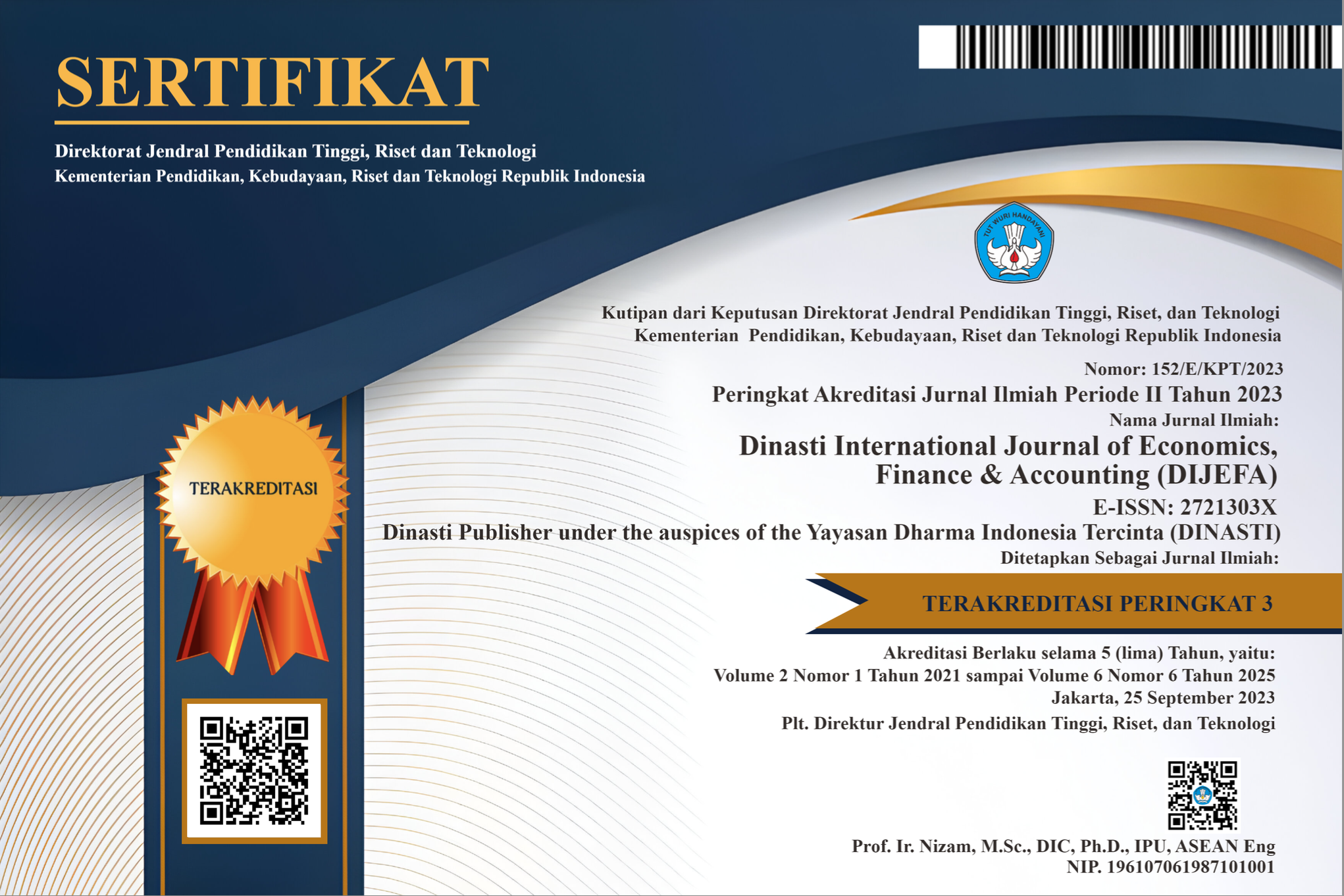Partial Least Squares Analysis: E-Marketing Orientation Model To Support Strategic Business Performance In The Weaving Industry In The District And City Of Payakumbuh
DOI:
https://doi.org/10.38035/dijefa.v5i4.3348Keywords:
E-marketing Orientation, E-trust, Strategic Business PerformanceAbstract
Weaving is a fabric-making technique whose raw material is fiber or yarn. Weaving is one of the forms of art that not only has aesthetic, but also has functional value in fulfilling daily needs. This study aims to see the effect of e-marketing orientation on strategic business performance mediated by e-trust in the weaving industry in Lima Puluh Kota Regency and Payakumbuh City. This study uses a quantitative approach, analyzed using the SEM-PLS method with a sample size of 36 people. The results showed that e-marketing orientation has a negative and insignificant influence on strategic business performance. E-marketing orientation has a positive and significant influence on e-trust. E-trust has a positive and significant influence on strategic business performance. E- marketing has a positive and significant influence on strategic business performance through the mediating role of e-trust. The implication of this research is that the potential of e-trust with e- marketing is an effective strategy in improving strategic business performance and achieving success in an increasingly competitive digital environment. So it is necessary to have a good understanding of e-marketing technology by paying attention to e-trust aspects and integrating it into marketing and operational strategies to achieve strategic goals.
References
Anser, M. K., Yousaf, Z., Usman, M., Yousaf, S., Fatima, N., Hussain, H., & Waheed, J. (2021). Strategic business performance through network capability and structural flexibility. Management Decision, 59(2), 426-445.
Adji, S. B., & Rubiyanti, N. (2023). Pengaruh Citra Merek Dan Kualitas Produk Terhadap Keputusan Pembelian Batik Effect Brand Image And Product Quality On Purchase Decisions Batik (Vol. 10, Issue 3).
Effendi, H., Osmet, O., and Ifdal, I. (2019). The Role of the Songket Industry in Increasing the Household Income of Craftsmen in Nagari Halaban, Lima Puluh Kota Regency. JISPO Journal of Social and Political Sciences, 9(2), 159-169.
El Saghier, N. (2021). The Effect of E-marketing Orientation on E-business Strategy: E-trust as a Mediator. Journal of Alexandria University for Administrative Sciences, 58 (2), 193- 242.
Gutandjala, M, S. The Effect of Digital Communication Technology on the Growth of Net Generation Character in Indonesia. Journal of Christian Religious Education, Vol. 4, No. 2, 2018
Hair, J. F. (2017). A Primer on Partical Least Squares Structural Equation Modeling (PLS-SEM) 2nd edition. Sage publications, 15-30.
Hendra, H., and Agustin, D. (2022). The Existence of Songket Halaban Weaving in Lima Puluh Kota Regency. Gorga: Journal of Fine Arts, 11(1), 202.
Hutagalung, L., Sinaga, P., Tan, J., and Tukiran, M. (2020). The Role of e-marketing and Customer Oriented on Business Performance Through Customer Loyalty and Hotels Competitive Advantage. Contigency: Scientific Journal of Management, 8(2), 202- 217. https://doi.org/10.56457/jimk.v8i2.163
Lillahi, K., & Hardi, E., (2022). History of Weaving Craftsmen in Balai Panjang Village, South Payakumbuh District, Payakumbuh City (1990-2020). Chronology Journal, Vol. 4, No. 3, Year 2022.
Lita, R., P., Meuthia, Surya S., Rahmi, D., Y. (2020) Digital Design-Based Product Innovation on Tenun Kubang in Lima Puluh Kota Regency. Journal of Community Service and Empowerment, Volume 4, No. 2 September 2020.
Oliveira, T., Alhinho, M., Rita, P., and Dhillon, G. (2017). Modeling and testing consumer trust dimensions in e-commerce Part of the Management Information Systems Commons Modelling and testing consumer trust dimensions in e-commerce. Computers in Human Behavior, 71, 153-164.
Rahimnia, F., and Hassanzadeh, J. F. (2013). The impact of website content dimension and e- trust on e-marketing effectiveness: The case of Iranian commercial saffron corporations. Information and Management, 50(5), 240-247. https://doi.org/10.1016/j.im.2013.04.003
Shabbir, B., and Xiaodong, Q. (2023). E-Loyalty and E-Marketing: A Matter of E-Trust. https://doi.org/10.20944/preprints202309. 0579.v1
Nofrialdi, R. ., Saputra, F. ., & Mahaputra, M. R. . (2023). Determinant Analysis of Business Risk with Institutional Ownership as a Moderating Variable. Siber International Journal of Digital Business (SIJDB), 1(1), 34–40. https://doi.org/10.38035/sijdb.v1i1.11
Shaltoni, A. M., West, D., Alnawas, I., and Shatnawi, T. (2018). Electronic marketing orientation in the Small and Medium-sized Enterprises context. European Business Review, 30(3), 272-284.
Sidek, S., Mohd Rosli, M., Azwa, N., Khadri, M., Hasbolah, H., Manshar, M., Mohd, N., Nik, F., Abidin, Z., Bharu, K., and Kelantan, M. (2020). Fortifying Small Business Performance Sustainability in the Era of Ir 4.0: E-Marketing as a Catalyst of Competitive Advantages and Business Performance. Journal of Critical Reviews, 7(13), 2143-2155. https://doi.org/10.31838/jcr.07.13.336
Sugiyono. (2016). Research Methods for Quantitative, Qualitative, and R&D Approaches. Bandung: Alfabeta.
Tiandra, N., Hambali, D., Nurasia, Rosalina, N., (2019) Analysis of the Effect of E-commerce on Improving MSME Performance (Case study on MSMEs in Sumbawa Regency). Indonesian Journal of Economics and Business, Vol 04, No. 01, 2019
Yousaf, Z., Sahar, N., Majid, A., and Rafiq, A. (2018). The effects of e-marketing orientation on strategic business performance. World Journal of Entrepreneurship, Management and Sustainable Development, 14(3), 309-320.
Downloads
Published
How to Cite
Issue
Section
License
Copyright (c) 2024 Faisal Ali Ahmad, Nelvia Iryani, Hutrisia Marafikha Afwa

This work is licensed under a Creative Commons Attribution 4.0 International License.
Authors who publish their manuscripts in this journal agree to the following conditions:
- The copyright on each article belongs to the author(s).
- The author acknowledges that the Dinasti International Journal of Economics, Finance & Accounting (DIJEFA) has the right to be the first to publish with a Creative Commons Attribution 4.0 International license (Attribution 4.0 International (CC BY 4.0).
- Authors can submit articles separately, arrange for the non-exclusive distribution of manuscripts that have been published in this journal into other versions (e.g., sent to the author's institutional repository, publication into books, etc.), by acknowledging that the manuscript has been published for the first time in the Dinasti International Journal of Economics, Finance & Accounting (DIJEFA).


























































